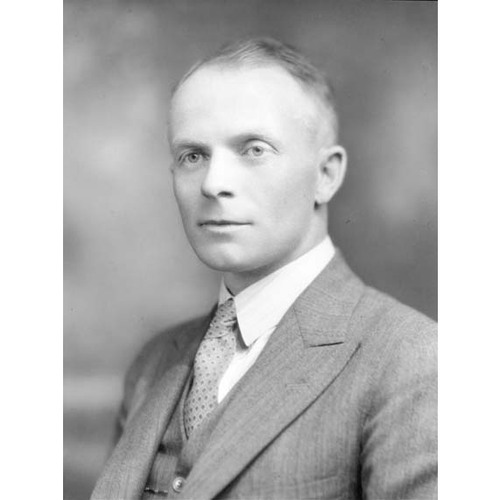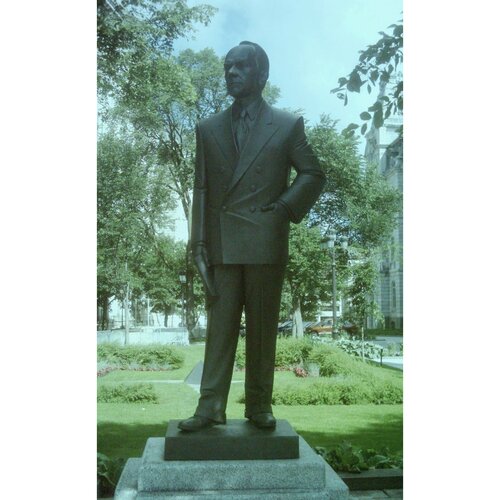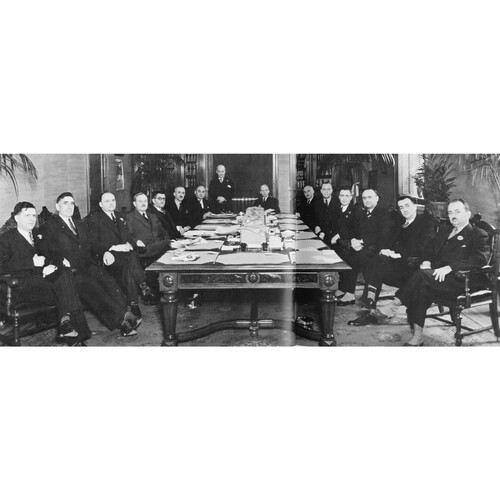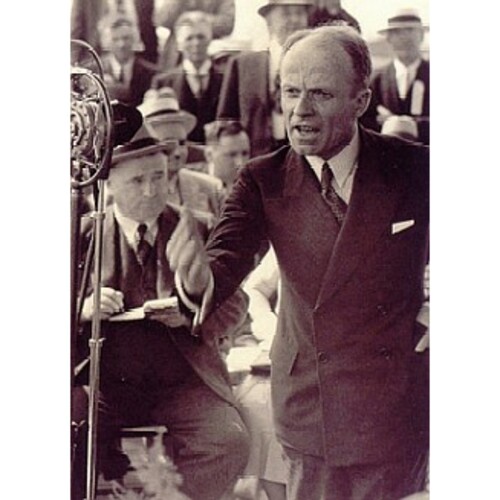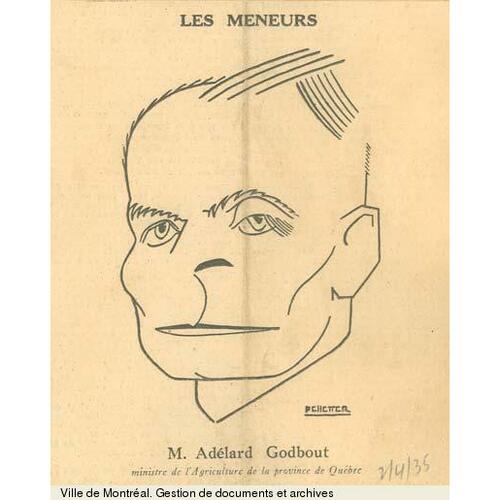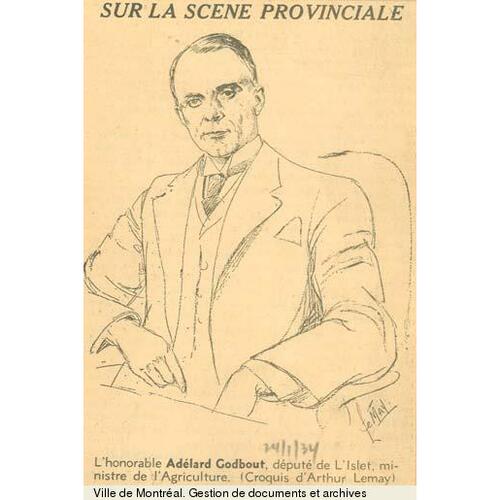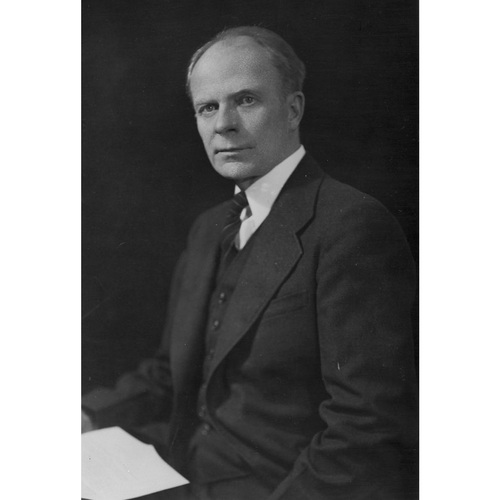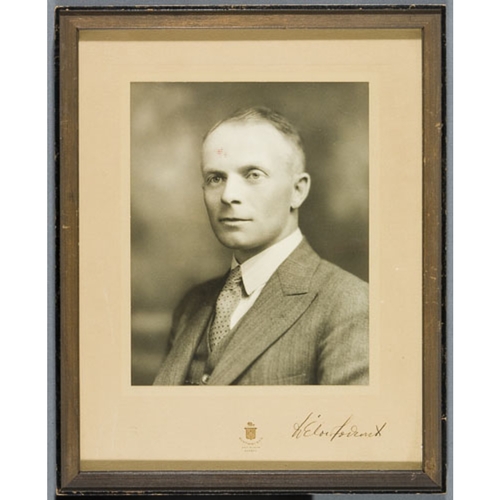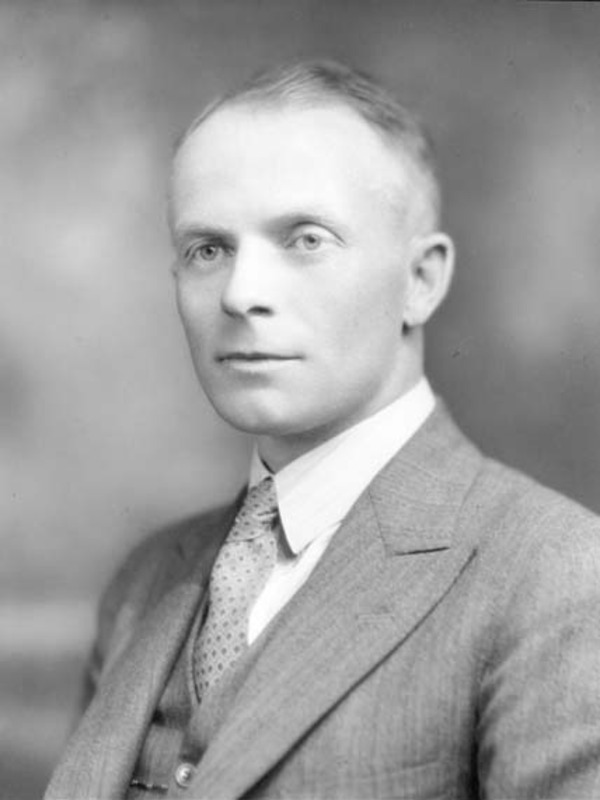
Source: Courtesy of Wikimedia Commons
GODBOUT, ADÉLARD (baptized Joseph-Adélard, he sometimes signed J.-Adélard), agronomist, teacher, civil servant, farmer, and politician; b. 24 Sept. 1892 in Saint-Éloi, Que., son of Eugène Godbout, a farmer, and Marie-Louise Duret; m. 9 Oct. 1923 Dorilda Fortin at Notre-Dame-de-Bon-Secours-de-L’Islet (L’Islet), Que., and they had five children; d. 18 Sept. 1956 in Montreal and was buried four days later in Frelighsburg, Que.
Education
Adélard Godbout was the 13th of 20 children in a relatively prosperous family from the lower St Lawrence region. His father, Eugène, succeeded in carving out an enviable position for himself in his community through business dealings in potatoes and horses. After completing his primary education at the local school in Saint-Éloi, young Adélard entered the Séminaire de Rimouski in 1905. Younger than most of his classmates, he showed talent but was somewhat undisciplined and nonchalant. In 1908 he suffered with knee pain. While convalescing, he missed the entire 1908–9 academic year. Back at the seminary in the autumn of 1909, he pursued his training more seriously and became one of the best students in his cohort. He finished his classical studies in 1913 and, intent on becoming a priest, entered the Grand Séminaire de Rimouski that year. The knee pain he had experienced in 1908 returned, however, seriously compromising his chances of joining the priesthood and putting an end to his ambitions. Following the advice of one of his teachers, Abbé Lionel Roy, he left the Grand Séminaire in 1915.
Godbout then made a choice that would have a decisive effect on his career: in 1916, he enrolled at the school of agriculture at Sainte-Anne-de-la-Pocatière to study agronomy. The development and teaching of this discipline was in its infancy in Quebec. Nevertheless, agronomy as an occupation had a promising future since it contributed extensively to the widespread professionalization, technical improvement, and standardization of product quality that characterized the province’s agricultural development and the government’s agrarian policy in the early decades of the 20th century. Despite the health problems that continued to plague him and forced him to rest periodically, Godbout excelled, especially in the field of animal science. In 1918 he was awarded a bsc with high honours in agricultural science.
Agronomist and teacher
The school of agriculture then offered Godbout the position of professor of specialized animal science and, the following year, sent him to further his education at the Massachusetts Agricultural College in Amherst. However, the needs of his alma mater were such that he had to interrupt his studies at the end of the first year and return to his academic post in 1920. He combined theory and practical work in his teaching, and focused on the anatomy of farm animals as well as on methods of livestock evaluation. According to the accounts of colleagues and former students, later compiled by the historian Jean-Guy Genest, Godbout was a well-liked teacher who knew how to combine effective presentation with penetrating content.
The expertise of agronomy teachers was in high demand. Godbout visited agricultural fairs, gave numerous lectures, and served regularly as a judge for livestock competitions. At the latter he established himself “as one of the top experts” according to the 1922–23 report of the Department of Agriculture of the province of Quebec. His reputation soon spread beyond the school of agriculture. From 1922 until 1925, when he resigned, he was also the official agronomist for the county of L’Islet. In this capacity he was the representative of the province’s agriculture department for the county’s farmers, becoming their technical adviser and bringing new life to farming in the area.
As county agronomist, Godbout assumed responsibility for the local branch of clubs for farm women, among other initiatives. It was in this setting that he met Dorilda Fortin, a young woman from Notre-Dame-de-Bon-Secours-de-L’Islet, who was the organization’s treasurer. After a few months of courtship, they married in October 1923 and settled in Sainte-Anne-de-la-Pocatière. The couple did not live extravagantly. Godbout’s salary, which was rather meagre, forced both to seek additional sources of income: at the local market he sold the surplus from his small farm, where he raised chickens and rabbits, while Dorilda engaged in knitting for a company.
Political debut
Godbout was born into a politicized family. His father had been mayor of Saint-Éloi in 1892–95 and in 1917–22. He had won a seat as the Liberal member for the riding of Témiscouata in the Quebec Legislative Assembly in a 1921 by-election. He had run again in the general election of 1923 but was defeated by the Conservative Jules Langlais. Owing to his family connections, young Godbout was no stranger to the provincial Liberal Party. In April 1929, when the seat of Élisée Thériault, mla for L’Islet, became vacant after he was appointed to the Legislative Council, Godbout became a choice candidate in this rural constituency. People knew him and he had made a good impression as the county agronomist. In addition, he had the backing of the riding’s Liberal organization. As well, the school of agriculture at Sainte-Anne-de-la-Pocatière approved of the possibility that one of its teachers might be elected and gain admission to the cabinet. Godbout allowed himself to be persuaded. Chosen unanimously as the Liberal Party candidate, he won the by-election unopposed on 13 May 1929. He would easily retain his seat in the general elections of 1931 and 1935. Upon being selected as Liberal candidate, he gave a speech in which he referred to the importance of education and the rise of modern agriculture as the foundation of the province’s economy. He returned repeatedly to these two themes throughout his political career.
Minister of Agriculture
In January 1930 Godbout began his first session at the Legislative Assembly. Initially, he concentrated primarily on fine-tuning the agricultural development plan of the new minister of agriculture, Joseph-Léonide Perron*. The Perron plan, as it would be known, was one of the highlights of the government’s program. Illness suddenly struck the minister in the summer of 1930 and led to his death in November, before he had had time to implement his plan, which caused great concern within the ruling party. Premier Louis-Alexandre Taschereau had to find a successor who would be capable of leading the agricultural reform initiative and defending the government’s agrarian policy. At the risk of offending the most experienced mlas, Taschereau decided to hand the reins of the agriculture department to Godbout, taking account of the high quality of his training, the abilities he had shown when backing the plan in Perron’s absence during the by-election in the autumn of 1930 in the Deux-Montagnes riding, and the need to rejuvenate and diversify his cabinet’s professional image. On 27 Nov. 1930, Godbout, aged 38, became Quebec’s minister of agriculture. That year the Université Laval in Quebec City awarded him an honorary doctorate in agricultural science; ten years later he would receive the same distinction, in veterinary medicine, from the Université de Montréal.
Godbout’s ministerial responsibilities disrupted his family life. He left the school of agriculture for good and, in the summer of 1931, settled with his family in Quebec City in a rented house on Chemin Sainte-Foy, near Route Belvédère (Avenue Belvédère). That year he acquired a farm in Frelighsburg, which he renovated and made his secondary residence. There he raised livestock and grew apples, a crop widely cultivated in the region.
As soon as he took office, young minister Godbout announced that he intended to pursue the implementation of the Perron plan. Two of its elements in particular bore his mark: agricultural instruction and management of the dairy industry. The latter was the subject of the principal legislation that came into force during his first mandate, namely the 1933 Act respecting milk and dairy products, which created the Dairy Industry Commission of the Province of Quebec. Initially vested with relatively limited investigative powers, the commission was considerably reinforced in 1934 by changes to the law that gave it, among other things, the authority to oversee and regulate the preparation, distribution, and sale of dairy products. According to Godbout, the purpose of these extraordinary powers was to guarantee milk producers a bigger share of their sales and allow better monitoring of milk distribution, especially in large cities. This important law was the culmination of government attempts to regulate prices and production in the province’s dairy industry. In Quebec, it represented a key moment in the evolution of agricultural policy towards a more active role by the state.
Godbout’s term as agriculture minister occurred during the worst years of the Great Depression of the 1930s, and he tried to help farmers during those difficult times. For example, he fought against the protectionism of Canada’s trading partners by asking delegates from the countries attending the Imperial Economic Conference, held in Ottawa in 1932 [see Richard Bedford Bennett*], for an exemption on some agricultural products. The next year he also introduced a bill to allow a temporary suspension of the obligations of debtors who were unable to repay mortgage loans.
First term as premier: 1936
Godbout made a good impression. His image as a competent, honest, moderate minister earned him praise from even the government’s fiercest opponents, such as the Montreal daily Le Devoir. His loyalty and ability to defend his administration’s policies convincingly – especially when confronted by Laurent Barré*, the opposition critic for agriculture and former president of the Union Catholique des Cultivateurs – earned him the respect of his cabinet colleagues. Following the 1934 creation of the Action Libérale Nationale by some of the most reform-minded members of the Liberal Party [see Paul Gouin*] and the revelation of scandals in the Taschereau administration in the spring of 1936 during the stormy sessions of the public accounts committee, the possibility of the premier’s departure was raised. Godbout appeared to be an excellent candidate to replace the leader, restore the party’s much-tarnished image, and bring dissidents back into the fold. Disquieted by the turn of events and re-energized by their victory in the federal election of 1935, the Liberal mps from Quebec, led by Ernest Lapointe* and Charles (Chubby) Gavan Power*, took an active part in discussions concerning the premier’s successor. At the end of complex negotiations, Godbout was an obvious compromise choice and became, it would seem reluctantly, Liberal Party leader and premier on 11 June 1936. Since the Legislative Assembly had been dissolved at Taschereau’s request, a general election was called for 17 August. With Lapointe’s help, Godbout replaced the entire cabinet and hastily put together a platform. It was not nearly enough to turn the tide: the Union Nationale – a new party created from the merger of the Action Libérale Nationale and the provincial Conservative Party, with Maurice Le Noblet Duplessis at its head – won the election hands down, garnering over 56 per cent of the vote and 76 of the 90 seats in the Legislative Assembly. Godbout did not escape the storm that swept away the Liberal Party: he was defeated by a handful of votes in his riding of L’Islet.
The leading lights of the Liberal Party immediately closed the door on the possibility of Godbout’s departure. Lapointe and Power, in particular, publicly declared their trust in him the day after the election. Despite the statement he had made on election night, the Liberal leader remained at his post and applied himself to rebuilding his party, while his colleague Télesphore-Damien Bouchard* took over as leader of the opposition in the Legislative Assembly. Godbout and his family, however, suffered financial consequences: without paid employment (the party did not have the means to give him a salary) or wealth accumulated over the years, their only income was generated by produce from the Frelighsburg farm, then debt-ridden because of the amounts they had had to invest in its improvement.
The high point of the Liberal Party’s rebuilding was the conference held in Quebec City on 10 and 11 June 1938. The conference – a first in the party’s history – brought together over 900 delegates from all regions of the province. Every association connected with the party was represented, including women’s organizations. The delegates confirmed Godbout in his position as leader and adopted the platform the Liberals would submit to voters at the next election. It contained numerous reforms aimed at bringing back to the party members of the defunct Action Libérale Nationale, many of whom felt short-changed by Duplessis. Among the proposed measures were the nationalization and municipalization of hydroelectric production still in the public domain, as well as women’s suffrage.
Second term as premier: 1939–44
Return to power
On 23 Sept. 1939, less than two weeks after Canada had declared war on Germany, Duplessis called an early election for 25 October. He hoped to obtain a mandate to defend provincial autonomy and oppose the nation’s involvement in the war. The provincial Liberals were ready. Godbout acquitted himself well, but it was the mp Lapointe who most distinguished himself in the Liberal camp. Incensed by Duplessis’s action, which he considered almost treasonous, Lapointe brought all his weight to bear on the election campaign and presented himself, as did his federal Liberal colleagues, who were also very active, as a bulwark against the conscription of Canadian subjects for the fighting overseas. Not to be outdone, Godbout made the following famous statement, published in the 6 October edition of Quebec City’s Soleil: “[I] undertake on my honour, weighing every word, to leave my party and even to fight it if a single French Canadian, between now and the cessation of hostilities in Europe, is mobilized against his will.” Galvanized by Lapointe’s vigorous, well-organized, and very generously financed campaign, and taking advantage of disappointment with the Union Nationale’s governance, the Liberals won a convincing victory, winning more than 54 per cent of the vote and 70 of the 86 seats in the assembly. Godbout easily regained his seat as the member for L’Islet and, on 8 Nov. 1939, once more became premier of Quebec, this time with a strong mandate.
As premier, Godbout first had to form his cabinet and place trusted people in key public-service posts. His principal advisers for this task were Lapointe and Bouchard, the latter obtaining the departments of roads and public works. The cabinet, which was smaller than that of Duplessis, numbered 14, including Godbout who, despite his heavy workload, took on the departments of agriculture and colonization.
Women’s suffrage
The vote for women was the first important legislation of Godbout’s government. For at least 20 years suffragists had demanded that the provincial government grant them the right to vote. The hostility of a large faction of the political and religious elites had ensured its rejection, even though women had had the right to vote federally since 1918. Godbout had voted against every bill to that end introduced in the assembly between 1930 and 1936. The premier justified his about-face by referring to the new social conditions, which would make it essential for women to participate in public life. It seems that the federal Liberals also contributed to this change of direction. Lapointe, especially, was in favour. At the 1938 conference he had backed the proposal by Thérèse Casgrain [Forget*], one of the pioneers of the suffrage movement and the wife of Liberal mp Pierre-François Casgrain*, to enshrine women’s right to vote in the party’s manifesto. The archbishop of Quebec, Cardinal Jean-Marie-Rodrigue Villeneuve*, fell in line with the opposition, declaring the measure ill-timed. Fearing that he would lose control of the debate, Godbout, according to Thérèse Casgrain, threatened the cardinal, saying he would resign if the clergy’s campaign against the bill continued. His departure would have led to Bouchard, who had an anticlerical reputation, being sworn in as premier. Despite opposition, the Act granting to women the right to vote and to be eligible as candidates finally received royal assent on 25 April 1940 [see The right to vote in provincial and territorial elections].
Civil Service Commission
From 1938 Godbout had expressed his intention of establishing a body that would be responsible for more transparent, more rigorous management in the hiring process for the province’s civil service, which would be set up along the lines of the federal Public Service Commission. The measure aimed to shield the province’s public administration from nepotism and favouritism, thereby making it stable and professional. The proposed legislation was announced in the speech from the throne on 2 Feb. 1943 and the Act to constitute a Civil Service Commission received royal assent on 23 June. It was, however, compromised right from the start: before it came into force, the Godbout administration had carried out 2,523 dismissals, accepted 1,543 resignations, and hired 4,685 new employees whose allegiance to the Liberal Party had reportedly worked in their favour. In Duplessis’s eyes, the reform therefore lost all credibility, with the result that, on his return to power in 1944, he would render the commission inoperative.
Nationalization and creation of Hydro-Quebec
On the economic front, Godbout’s government was characterized by a much greater interventionist, dirigist approach than those of its predecessors under the Liberals Sir Lomer Gouin* and Taschereau. In 1943, anticipating the post-war period, Godbout had succeeded in passing the Act to institute an Economic Advisory Council. It was responsible for developing an economic and labour redeployment program. That year he opened the Raffinerie de Sucre de Québec, a government enterprise tasked with refining beet sugar, in Saint-Hilaire (Mont-Saint-Hilaire).
From an economic standpoint, however, the highlight of Godbout’s administration was the nationalization of Montreal Light, Heat and Power Consolidated [see Louis-Joseph Forget*] and the creation of Hydro-Quebec. The project was the culmination of a debate that had reached a peak of intensity during the 1930s. Founded in 1901, the Montreal Light, Heat and Power Company had been taken over in 1916 by the Civic Investment and Industrial Company, which was renamed Montreal Light, Heat and Power Consolidated two years later. It acquired companies and ended up claiming a monopoly over the distribution and sale of electricity and natural gas in Montreal. In the 1930s some public opinion turned against the electricity trust and demanded that the government more strictly regulate the energy sector and more closely monitor the profits of the companies associated with it and their tariffs on consumption. In 1934 the Taschereau government set up a commission of inquiry, chaired by Lapointe, to assess the electricity industry in Quebec. In May 1935, after receiving the recommendations of the commission, the government established the Régie Provinciale de l’Électricité (renamed the Régie des Services Publics in 1940), a permanent government body with the power to investigate and oversee private companies and individuals involved in producing and selling electricity. Following an investigation begun in 1938, the commission revealed its damning conclusions in 1943: Montreal Light, Heat and Power Consolidated levied excessive tariffs and had engaged in questionable financial dealings. In addition, demand from rural areas for electricity was becoming increasingly pressing. Production and distribution companies were little inclined to develop this market, which was much less profitable than urban business. Therefore, Godbout, who, in the early 1930s had been rather sympathetic to the companies’ cause, was henceforth inclined to favour nationalization. As Quebec City’s L’Action catholique reported on 29 March 1944, he went so far as to describe the company administrators as “bandits” and their management as “an unscrupulous fraudulent economic dictatorship.” That year his government introduced a bill in the assembly proposing the nationalization of Montreal Light, Heat and Power Consolidated and the Beauharnois Light, Heat and Power Company, along with their subsidiaries. The bill also created the Quebec Hydro-Electric Commission, or Hydro-Quebec, which would take over the assets and services of the expropriated firms. Despite strenuous opposition from the latter, their shareholders, and those in political, economic, and intellectual circles who were alarmed by what they viewed as the Act’s socialist tendencies, it received royal assent on 14 April 1944. The mandate of the new state enterprise included supplying electricity at low rates and providing electricity to rural areas. L’Action catholique added that, for Godbout, the legislation was “the most important to have been crafted by this legislature since confederation.”
Labour Relations Act
Godbout’s government also distinguished itself in the field of labour law. Despite the price controls imposed by the federal government, economic prosperity brought about by the Second World War raised the spectre of inflation. Workers feared a reduction in their spending power. Furthermore, many conflicts arose from some employers’ refusal to recognize and negotiate with unions. As a result, the period was punctuated by several major strikes. Rushing into action, the government drafted the Labour Relations Act, which went into force on 3 Feb. 1944. It was inspired by American labour legislation and followed the recommendations of the Prévost commission, whose mandate included investigating the grim strike that had affected the factories of paper maker Price Brothers Limited [see Sir William Price*] in 1943. The act was passed barely two weeks before a similar decree was issued by the federal government, as the province feared that Ottawa would take over an area of its jurisdiction. The Godbout government’s legislation recognized the right of association of all employees, obliged bosses to negotiate in good faith with established unions, extended the application of collective agreements to all workers in a company rather than solely to union members, made arbitration before the beginning of a strike or lockout mandatory, and outlawed strikes during the term of a collective agreement. The law was therefore a significant event in Quebec’s union history: it laid out general principles that were to govern labour relations for the long term, as well as the framework in which they were to take place.
Culture and education
Godbout’s government also left its mark on matters of culture and education. In the cultural domain it bought the Bibliothèque Saint-Sulpice [see Ægidius Fauteux*] in 1941 – whose collection would be incorporated into the Bibliothèque Nationale du Québec, established in 1967 – from the Sulpicians, and founded the Institute of Music and Dramatic Art of the Province of Quebec in 1942 [see Wilfrid Pelletier*]. Its most noteworthy initiatives, however, were in education. Renewed economic prosperity allowed the government to complete the construction of the Université de Montréal’s new main building, which was inaugurated in 1943 [see Louis de Lotbinière Harwood*]. Even more importantly, Godbout, who since entering politics had made education one of his priorities, decided to take on the issue of compulsory education. The subject was a thorny one: it had been discussed since the end of the 19th century and every attempt to institute it had failed. While anglophone Protestants had traditionally been in favour of the measure, it was disliked by francophone Roman Catholic elites, both religious and secular, who controlled education in the province. In their eyes compulsory education had become synonymous with anticlerical policies designed to strip the Church and parents of their prerogatives in educational matters to the advantage of the state. By the time Godbout came to power in 1939, however, things had changed. Pope Pius XI had acknowledged that compulsory education was justified, provided it met certain conditions. Moreover, the labour market increasingly required qualified workers. The circle of advocates for this kind of reform had therefore greatly widened. From 1940 to 1942 Victor Doré, superintendent of public instruction, and Hector Perrier*, the provincial secretary responsible for the Department of Public Instruction in the cabinet, carried out various investigations into school attendance by questioning individuals in the education community. Statistics from this research were telling: class attendance left much to be desired and many children dropped out of school before completing their elementary education. Armed with this data, Godbout’s government tried to obtain support from the clergy, a condition that was essential to the reform’s success. The issue divided the province’s bishops, but Cardinal Villeneuve, one of those who backed the government’s position, took on the task of persuading most members of the Catholic Committee of the Council of Public Instruction of the need for reform. The committee approved the measure at its meeting on 17 Dec. 1942. With this major obstacle out of the way, there remained the job of convincing several Liberal caucus members who were against reform. Perrier, who had introduced the bill in the assembly, proved persuasive and the Act respecting Compulsory School Attendance, which applied to children aged 6 to 14, received royal assent on 26 May 1943.
Social legislation
The appeal of state welfare to Godbout’s administration was also clearly evident in the field of social legislation. Its main social-policy projects, all highly ambitious, were to meet with failure. Three stood out. The first dealt with family benefits. In 1943 the Legislative Assembly approved the Act respecting the payment of family allowances under Collective Labour Agreements. To Godbout, this arrangement seemed fairer and more flexible than government-financed family aid. The plan failed, however, because it was optional. The second bill dealt with health insurance. In June 1943 the government created the Quebec Health Insurance Commission – which Duplessis would abolish in 1945 – responsible for preparing a broadly based health insurance scheme. The plan never saw the light of day, and six months later, following the deaths of numerous children in Montreal day nurseries, the commission’s mandate was altered and the premier asked its members to explore the issue of child protection. They tabled their report in April 1944. The government adopted their recommendations and drafted bold legislation to create a state-supervised umbrella network for youth, which included the power to investigate religious charitable organizations, traditionally responsible for orphans and young delinquents. It was the third major social-legislation bill of Godbout’s administration. The Act respecting the Protection of the Children, which came into force on 3 June 1944, was not well received in Catholic and conservative circles, where it was viewed as a measure tainted with secularism and an attack on the denominational nature of the organizations that looked after children. Duplessis, disagreeing with the spirit of the bill, would suspend its implementation on his return to power later that year.
Federal relations and conscription
Godbout’s mandate as Quebec’s provincial leader was greatly affected by the Second World War and his administration’s relations with Ottawa, external factors that weighed enormously on his government and contributed to sealing its fate. Godbout’s position regarding these matters was consistent between 1939 and 1944: the province fully backed the Allies and whole-heartedly supported the country’s war effort by cooperating in good faith with the federal government so that Canada would be united in a common front in these exceptional circumstances. Premier Godbout was deeply attached to his province. However, he felt little affinity with aggressive French Canadian nationalism, with its insistent demands and antagonism towards the federal government and English Canada. His patriotism embraced the whole of Canada, and he remained convinced that it was possible to create a united Canada that respected the country’s cultural duality. Godbout’s election in 1939 delighted and relieved the federal Liberals. Prime Minister William Lyon Mackenzie King* came to have great respect for him. The day after Lapointe’s death and at a critical juncture in the war, he begged Godbout, in terms that revealed the depths of his distress in a letter dated 30 Nov. 1941, to replace the late minister of justice in Ottawa and become his new lieutenant in Quebec: “Frankly, my dear Godbout, I am completely at a loss to know how the party, the government and the country are to be kept united unless I have someone from Quebec like yourself at my side, and that immediately.” Godbout refused, citing his imperfect English, the importance of his role as premier in the war effort, and the risk that his departure would cause the rupturing of the provincial Liberal Party. His relations with the federal government, however, were more complex and problematic than they seemed. Godbout was constantly caught between, on the one hand, his loyalty to Canada and the Liberal Party, as well as his wish to contribute to the war effort, and on the other, the political need to prove himself a strong defender of Quebec’s rights and interests. On 27 Feb. 1942 he made the following statement to this effect in the Legislative Assembly: “I am proud of my province and I believe we shall be able to place it in the front rank of all the provinces of the Dominion. We are in Confederation, working heart and soul with other groups in the country.… Let us prove that our minds are broad enough to understand the Canadian issue as a whole and our spirit great enough to embrace with unstinting affection the entire Canadian homeland from the Atlantic to the Pacific.”
Publicly, a spirit of cooperation and openness prevailed. Accordingly, in 1940 Godbout had consented to a constitutional change by which the province ceded the establishment of and the responsibility for unemployment insurance to the federal government, only revealing his misgivings about this decision to Prime Minister King in their private correspondence. At the federal–provincial conference in January 1941, occupied with studying the report of the royal commission on dominion–provincial relations (or the Rowell–Sirois commission) [see Newton Wesley Rowell*; Joseph Sirois*], he started out cautiously and did not adopt an official position on the document’s recommendations. At the time, the premiers Mitchell Frederick Hepburn of Ontario, William Eberhart* of Alberta, and Thomas Dufferin Patullo of British Columbia proved to be the staunchest guardians of provincial prerogatives. In consideration of the war effort, Godbout followed the example of the other premiers by approving a measure – part of a tax accord – whereby in 1942 the province ceded temporarily its power of direct taxation to the federal government with the expectation that it would receive compensation. These conciliatory actions were harshly criticized by Duplessis and succeeded in enraging nationalists. In their view Godbout demonstrated naivety and weakness, and they saw the federal government’s manoeuvres as the desire to take advantage of its extraordinary wartime powers to alter the long-term balance of power in the Canadian federation.
As a matter of principle, and because it was wartime, Godbout only revealed his disagreements with the federal government in private, obtaining mixed results. Accordingly, he sent numerous letters to King and the new minister of justice, Louis-Stephen St-Laurent*, in which he criticized, for example, changes made to federal divorce legislation, the inadequate defence of the shores of the Gulf of St Lawrence and its estuary against attacks by German submarines, the federal family allowances bill, the delay in changes to the federal electoral map, and Ottawa’s intrusion into the field of professional training. He also requested that tax agreements preserve provincial autonomy.
The conscription debate, however, was the issue that proved the most wrenching for Godbout, who was caught between the promise he had made to the electorate in 1939 to oppose firmly any attempt to impose compulsory military service, and his desire to contribute to the war effort and align himself with his federal political allies. He was also caught between various factions of his own party. In the plebiscite of April 1942 there were Liberals in both camps: on the one hand, a group in favour of conscription, led by members elected in mainly anglophone ridings, and on the other, a group opposed to conscription led by provincial ministers with nationalist sympathies, such as Oscar Drouin, Wilfrid Hamel*, and Léon Casgrain. Godbout’s unconvincing, even ambiguous, opposition to conscription and his refusal to take a stand on the plebiscite, in which the federal government asked the Canadian people to release it from its promise not to impose conscription for overseas service [see William Lyon Mackenzie King], allowed him to keep his party united and manage his relations with the federal government. In the end, however, these issues set all the province’s nationalist forces against him, including its reformist group, which had supported him in 1939.
The 1944 election
On 28 June 1944 Godbout called a general provincial election for 8 August, the first in which women were to vote. His plan was simple: he wanted the campaign to focus on his legislative record and the quality of his government’s management of the province’s affairs. The opposition, led by the Union Nationale, undertook to concentrate its attacks on the issue of provincial autonomy and channel against the Liberals all the dissatisfaction of a segment of Quebec’s French Canadian population for their positions on the conduct of the war, especially for imposing conscription and redefining shared federal and provincial responsibilities to the advantage of the former. Despite the division in the nationalist vote, part of which was captured by the Bloc Populaire Canadien, the strategy succeeded: the Liberals won the largest percentage of the ballots cast (39.4 per cent for 37 seats), but the distortion caused by the voting method and the electoral map awarded a small majority of seats to the Union Nationale (38 per cent of the vote for 48 seats). Other factors compromised Godbout’s campaign, including the defection of the party’s financial backers, who had broken with his government over what were perceived as its socialist leanings, and the decrease in support from rural voters, who found a better response to their aspirations in the Union Nationale. There was also apathy among certain elements of the activist base, who were unhappy with their inability to sufficiently benefit from favouritism, and with the party’s association with people perceived as radical anti-nationalists and anticlericals, such as Télesphore-Damien Bouchard.
Leader of the opposition: 1944–48
Despite the defeat, Godbout remained leader of the opposition. At the end of 1944, when the federal government announced the imposition of conscription for military service overseas, he found himself forced to dissociate the provincial Liberal Party from its federal counterpart. The constitutional terrain remained a minefield for the party, and its association with the highly centralizing policies of the federal Liberals caused it to lose more and more ground to the Union Nationale. When the 1948 general election was called, the latter was in a strong position: it attracted all shades of nationalist opinion, and benefited from solid funding, an efficient organization, and formidable election propaganda. The Liberals were very vulnerable on the question of provincial autonomy. The verdict at the polls, delivered on 28 July, was harsh: the Union Nationale garnered 51.2 per cent of the vote and sent 82 mlas out of 92 to the Legislative Assembly. With 36.2 per cent of the vote, the Liberals had only 8 members, and to his great dismay, Godbout, leader of the opposition, lost the riding of L’Islet by 40 votes.
Senator: 1949–56
Godbout remained head of the party, but the loss of his mla salary plunged him once more into financial difficulty. His political friends came to the rescue, and on 25 June 1949, St-Laurent, the new prime minister, appointed him senator for the division of Montarville. The politician Georges-Émile Lapalme* was later to recount in his Mémoires a conversation during which Godbout, giving a bittersweet account of his years in politics and deploring the state of his personal finances, is reported to have told him, “In appointing me a senator, Mr St-Laurent put food on my table.” His appointment to the Senate marked the end of his official association with the provincial Liberal Party. On 22 July 1949 George Carlyle Marler*, who had been serving as parliamentary leader of the Liberals in the Legislative Assembly since the 1948 election, was appointed, with Godbout’s backing, interim leader of the party.
Assessment
In the last years of his life, Godbout divided his time between his farm in Frelighsburg, now his permanent residence, and Ottawa, where he carried out most of his work on parliamentary Senate committees. He took advantage of a peaceable semi-retirement to manage his farm, devote himself to reading, and enjoy the company of his family and friends. He generally stayed away from partisan politics, aside from the occasional public appearance in support of Lapalme, the provincial Liberal Party leader from 1950 to 1958. In the early hours of 18 Sept. 1956, he felt faint, fell on the stairs of his house, and cracked his skull. He was rushed to Notre-Dame Hospital in Montreal, where, notwithstanding a lengthy operation to try to save him, he died that evening.
Despite the brevity of his term as head of the government, Godbout had a considerable influence on the future of Quebec, as well as that of the provincial Liberal Party. As premier, he showed political courage and skill in resolving two thorny issues that had been pushed aside for decades by preceding governments: women’s suffrage and compulsory education. In addition, at least two of the major bills that took effect while he was in office helped to shape the province’s economy, namely the creation of Hydro-Quebec, which would be the foundation of Quebec’s energy policy, and the Labour Relations Act, which would establish the framework governing relations between employers and workers in the province.
Godbout greatly transformed the provincial Liberal Party. Under his leadership, it abandoned classic economic liberalism and resolutely embraced neoliberalism and state welfare. It also began to adopt modern forms of political organization, as was demonstrated at the 1938 conference, and it became an urban party whose electoral and activist base was henceforth to be found in towns and cities rather than in rural areas. In the end the dynamics of relations between the provincial and federal Liberal parties established under Godbout, which were to last throughout the 1950s, would lead to an impasse that caused the official dissociation of the two groups in 1964 and the full autonomy of the provincial wing.
Adélard Godbout was a competent and honest politician, a good speaker, respected even by his adversaries. Many organizations and institutions recognized this agronomist’s contribution to the advancement and modernization of agriculture; they even made him a symbol of excellence for posterity. Somewhat unsure of himself, however, he lacked the strong ambition and decisiveness characteristic of great statesmen. Placed in exceptionally difficult circumstances, he never managed to decide between his loyalty to Canada and his federal political friends on the one hand and his concern with serving Quebec and protecting its rights on the other. Ultimately, and despite a very respectable track record, this ambivalence was doubtless the cause of his political downfall.
Historian Jean-Guy Genest’s phd thesis “Vie et œuvre d’Adélard Godbout, 1892–1956,” which was deposited in 1977 at the Univ. Laval, was published almost 20 years later under the title Godbout (Sillery [Québec], 1996). This biography, very laudatory but nevertheless complete, is based on, among other things, an exhaustive examination of archival material and numerous interviews with parents, friends, and colleagues of the former premier. Although modest in scope, the Adélard Godbout fonds (P712), held by the Bibliothèque et Arch. Nationales du Québec, Centre d’arch. de Québec, provides a relatively good record of Godbout’s tenure as the head of Quebec (1939–44); it contains his speeches and correspondence as well as subject files. Denis Monière collected and presented several of Godbout’s most important speeches in Adélard Godbout vous parle ([Montréal et Québec, 2010]). A complete list of works, brochures, and articles covering various aspects of his personal and political life can be found in Michel Lévesque and Martin Pelletier, Le Parti libéral du Québec: bibliographie (1867–2006) (Québec, 2006).
Bibliothèque et Arch. Nationales du Québec, Centre d’arch. du Bas-Saint-Laurent et de la Gaspésie–Îles-de-la-Madeleine (Rimouski, Québec), CE104-S18, 25 sept. 1892. Fonds Drouin, Notre-Dame-de-Bon-Secours (L’Islet, Québec), 9 oct. 1923. Library and Arch. Can., “Diaries of William Lyon Mackenzie King”: www.bac-lac.gc.ca/eng/discover/politics-government/prime-ministers/william-lyon-mackenzie-king/Pages/diaries-william-lyon-mackenzie-king.aspx (consulted 16 Dec. 2015). L’Action catholique (Québec), 8 mai 1929; 17 mars 1934; 18, 19 août 1936; 11 juin 1938; 16 janv. 1941; 18 déc. 1942; 7 mai, 9 oct. 1943; 19 sept. 1956. Le Devoir (Montréal), 21 sept. 1956. La Patrie (Montréal), 5 avril 1933; 1er oct. 1939; 4 juin 1943; 19, 24 sept. 1956. L.‑P. Audet, Histoire de l’enseignement au Québec (2v., Montréal et Toronto, 1971), 2. L.‑R. Betcherman, Ernest Lapointe: Mackenzie King’s great Quebec lieutenant (Toronto, 2002). Canadian parliamentary guide (Ottawa), 1956. René Chaloult, Mémoires politiques (Montréal, 1969). C. L. Cleverdon, The woman suffrage movement in Canada, intro. Ramsay Cook (2nd ed., Toronto, 1974). Gilles Gallichan, “De la Montreal Light, Heat and Power à Hydro-Québec,” dans Hydro-Québec: autres temps, autres défis, sous la dir. d’Yves Bélanger et Robert Comeau (Sainte-Foy [Québec], 1995), 63–70. J. I. Gow, Histoire de l’administration publique québécoise, 1867–1970 (Montréal et Toronto, 1986). Clarence Hogue et al., Québec: un siècle d’électricité (Montréal, 1979). Renée Joyal et Carole Chatillon, “La loi québécoise de protection de l’enfance de 1944: genèse et avortement d’une réforme,” dans L’évolution de la protection de l’enfance au Québec: des origines à nos jours, sous la dir. de Renée Joyal (Sainte-Foy, 2000), 131–62. Marcel Labelle, Adélard Godbout: précurseur de la Révolution tranquille ([Montréal], 2007). Hector Laferté, Derrière le trône: mémoires d’un parlementaire québécois, 1936–1958, Gaston Deschênes, édit. (Sillery [Québec], 1998). G.‑É. Lapalme, Mémoires (3v., [Montréal], 1969–73), 1. Vincent Lemieux, Le Parti libéral du Québec: alliances, rivalités et neutralités (Québec, 2008). Michel Lévesque, Histoire du Parti libéral du Québec: la nébuleuse politique, 1867–1960 (Québec, [2013]); “Pour en finir avec le bon et juste Adélard Godbout,” L’Action nationale (Montréal), 96 (2006), no.10: 45–52. Dominique Marshall, The social origins of the welfare state: Québec families, compulsory education, and family allowances, 1940–1955, trans. Nicola Doone Danby (Waterloo, Ont., 2006). C. G. Power, A party politician: the memoirs of Chubby Power, ed. Norman Ward (Toronto, 1966). Que., Legislative Assembly, Journals, 1930–44; Minister of Agriculture, Report, 1918–44; National Assembly, “Quebec dictionary of parliamentary biography, from 1764 to the present”: www.assnat.qc.ca/en/membres/notices/index.html (consulted 23 Jan. 2020); Statutes, 1930–44. Jacques Rouillard, “Aux sources de la Révolution tranquille: le congrès d’orientation du Parti libéral du Québec du 10 et 11 juin 1938,” Bull. d’hist. politique (Montréal), 24 (2015–16), no.1: 125–58; Histoire du syndicalisme au Québec: des origines à nos jours (Montréal, 1989). Robert Rumilly, Histoire de la province de Québec (41v., Montréal et Paris, 1940–69), 31–41. Jennifer Stoddart, “The women suffrage bill in Quebec: public opinion as reflected in the press,” in Women in Canada, ed. Marylee Stephenson ([Toronto], 1973), 90–106. Reginald Whitaker, The government party: organizing and financing the Liberal Party of Canada, 1930–58 (Toronto, 1977).
Cite This Article
Dominique Foisy-Geoffroy, “GODBOUT, ADÉLARD (baptized Joseph-Adélard) (J.-Adélard),” in Dictionary of Canadian Biography, vol. 18, University of Toronto/Université Laval, 2003–, accessed April 10, 2025, https://www.biographi.ca/en/bio/godbout_adelard_18E.html.
The citation above shows the format for footnotes and endnotes according to the Chicago manual of style (16th edition). Information to be used in other citation formats:
| Permalink: | https://www.biographi.ca/en/bio/godbout_adelard_18E.html |
| Author of Article: | Dominique Foisy-Geoffroy |
| Title of Article: | GODBOUT, ADÉLARD (baptized Joseph-Adélard) (J.-Adélard) |
| Publication Name: | Dictionary of Canadian Biography, vol. 18 |
| Publisher: | University of Toronto/Université Laval |
| Year of revision: | 2022 |
| Access Date: | April 10, 2025 |


